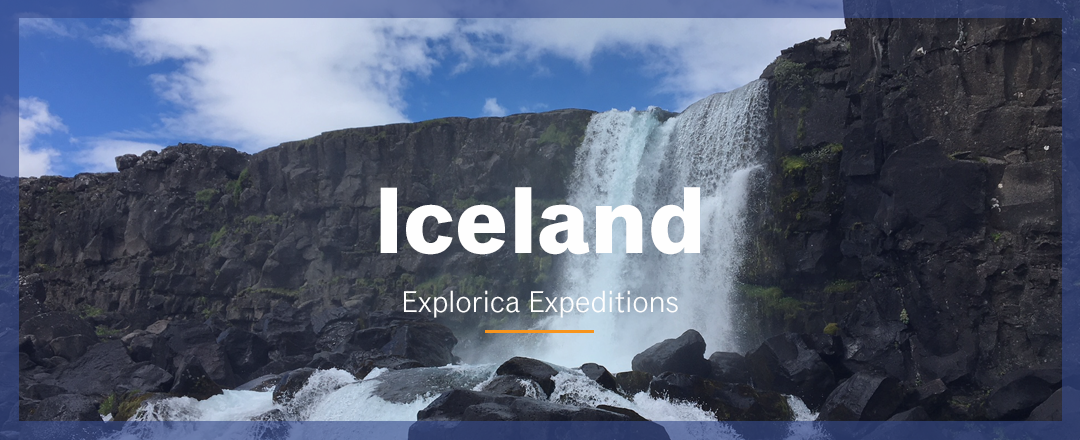Jessica Taylor Price is a copywriter in Explorica’s Boston headquarters. She went on a five-day trip to Iceland this past July.
Read her story:
Why did I decide to go to Iceland? It’s pretty simple: I wanted to see puffins on my birthday. I wanted to go on a trip that was primarily nature-based. And, because my husband is in Germany for the summer, I wanted to go on a trip in that general direction. Iceland was the clear choice.
I’d also heard great things about Iceland. The country’s been gaining traction in recent years as a hot tourist destination, so plenty of people have come back and recommended it to me, and after my visit I can tell you that it totally deserves the hype. It was an incredible experience, with or without puffins (though my trip had puffins).
Here’s an overview of my puffin-filled trip to Iceland. Check out our tours to Iceland, and note that the activities in this post with an asterisk are not on those itineraries. Alternate activities are provided where possible, but you could also just talk to your program consultant about customizing your itinerary to make it look more like mine.
Day 1: Flight to Iceland
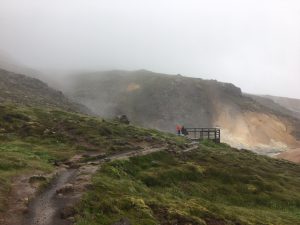
My flight arrived at Iceland’s main airport, in Keflavik, around five in the morning, though the sun was well up: At this time of year, it rises at 3AM and doesn’t set until midnight.
It was wet and muggy, and I was exhausted from the time difference and traveling, but I had 12 hours to kill until my husband’s flight got in, so I got in my rental car and headed to Kleifarvatn Lake,* a beautiful lake in the Reykjanes Peninsula that has no inlet. I drove around the lake and got a pretty good look at the rock formations.
I then headed to the Seltún* geothermal area. The first thing I noticed about Seltún is that it stank of sulfur, something I would have to get used to over the course of the week and that locals don’t even notice. At Seltún, I saw colorful sediments, bubbly, boiling water coming out of the ground, and mud pools (Alternate activities: Lake Myvatn and Akureyri thermal pool).
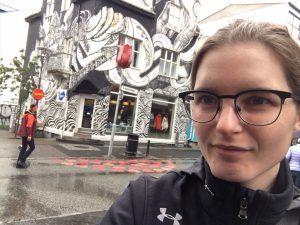
Once my husband arrived, we headed to Reykjavik for a quick look around. Reykjavik is little in comparison to our hometown of Boston, but we had fun walking around through an old cemetery and ending up in Ingólfstorg Square, the main square, and where on that particular day locals were watching the world cup on a big screen. We also got a glimpse of Hallgrímskirkja, a huge and imposing church built to resemble a glacier. Compared to the rest of the buildings, which are mostly small and some covered in modern mural art, the church was stark.
Day 2: West Iceland and the Blue Lagoon
The next day, we ventured out to Western Iceland, a less well trodden part of the country, but exciting nonetheless. We had plenty of long car rides on this trip, with this being the first, and the landscape became familiar to us after a while: lots of lava fields of black rock covered in green moss, and purple flowers called lupines littering the landscape. Sheep, cows, and Icelandic horses were super common, and got me excited every time.
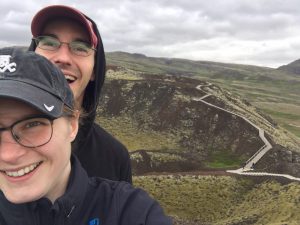 We first arrived at Grábrók crater, an inactive volcano surrounded by a lava field. We walked through the lava field and up onto the rim of the crater via a boardwalk that took us all the way around it. It was a very pretty view from the top, including some Icelandic horses.
We first arrived at Grábrók crater, an inactive volcano surrounded by a lava field. We walked through the lava field and up onto the rim of the crater via a boardwalk that took us all the way around it. It was a very pretty view from the top, including some Icelandic horses.
Our next stop was Hraunfosser, the waterfall I was most looking forward to seeing. Hraunfosser is special because it looks like the water is coming from nowhere: In fact, it emerges through volcanic rock in tiny streams. A short walk away was Barnafoss, a larger and more powerful waterfall named for children that had fallen in, according to lore. We walked over bridges and on boardwalks to see the waterfalls from different angles.
On the way back, we walked around Deildartunguhver, a very hot and steamy hot spring that, again, reeked of sulfur, before heading to the world-famous Blue Lagoon.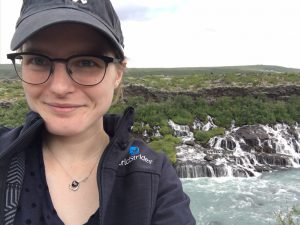
The Blue Lagoon is man-made, very touristy, and locals wouldn’t be caught dead there, but it’s definitely worth visiting nonetheless. Even though thousands of people visit each day, it’s not crowded in the water, which is deep blue, warm, and great for your skin. The lagoon is fun to explore—you can go off and find a little nook to take a photo (if you have a waterproof phone case), and just relax and enjoy the hot water. Don’t forget to also get some complimentary face scrub as well.
Day 3: Westman Islands*
Day three was the big day. It was my birthday so there was a lot riding on this part of the trip, including whether puffins would be willing to come out and show off their big orange beaks that day.
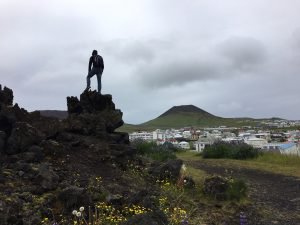 We took a ferry to the Westman Island of Heimaey,* just off the southwest coast of Iceland. With just over 4,000 people, Heimaey is the only inhabited island of the Westman Islands, which were formed by volcanic eruptions. We saw some of the smaller islands before reaching Haimaey, a small and beautiful island partially covered in (and made larger by) volcanic rock from an eruption back in 1973.
We took a ferry to the Westman Island of Heimaey,* just off the southwest coast of Iceland. With just over 4,000 people, Heimaey is the only inhabited island of the Westman Islands, which were formed by volcanic eruptions. We saw some of the smaller islands before reaching Haimaey, a small and beautiful island partially covered in (and made larger by) volcanic rock from an eruption back in 1973.
The effects of the 1973 eruption were very clear: You could climb up over the rocks that were formed in the eruption, and even see street signs that marked off the areas where streets and homes were covered in lava. The Volcano Museum*—close to the island’s two volcanoes, one of which was the culprit—told the story of the eruption, including the effort to evacuate all inhabitants of the island, many of whom left with little to no belongings. During our walk around the island and in the museum, we saw a building that was partially submerged, a home that had been dug out of the lava (the museum was actually built around it), and a huge water tank that had been half taken over by magma. (Alternate activity: Lava Centre)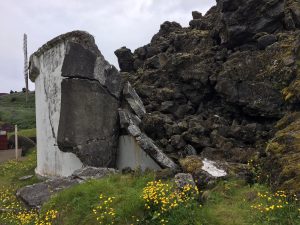
Other than the incredible landscape, the highlight of Haimaey was the puffins. We went to Saeheimar Aquarium,* which is famous for its four resident puffins that walk around and greet people. When baby puffins (“pufflings”) leave the nest, sometimes they get confused by the bright lights in town and end up on the streets instead of the uninhabited parts of the island. The children of Haimaey are tasked with scooping them up and delivering them to the aquarium, which rehabilitates and releases all but a few pufflings. That’s where we met a very special puffin named Hefdis, a rescue puffin who needed swimming lessons. She was very tired and took a nap on the table while I spoke to her. It was incredible.
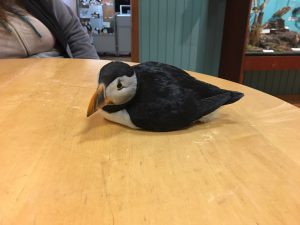 We also walked around the rest of the islands on the lookout for puffins in the wild. There were many seagulls, and it was hard to spot the much darker puffins since they blend in with the landscape. We quickly learned how to spot them: They’re much smaller than seagulls, and from far away you can tell it’s a puffin by how rapidly it flaps its wings, sort of like a bat. We saw several flying overhead, making the rounds of the island, and returning to their nests on the cliffside #BestBirthdayEver.
We also walked around the rest of the islands on the lookout for puffins in the wild. There were many seagulls, and it was hard to spot the much darker puffins since they blend in with the landscape. We quickly learned how to spot them: They’re much smaller than seagulls, and from far away you can tell it’s a puffin by how rapidly it flaps its wings, sort of like a bat. We saw several flying overhead, making the rounds of the island, and returning to their nests on the cliffside #BestBirthdayEver.
Day 4: Golden Circle
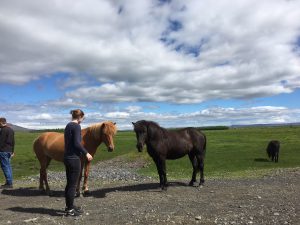
The Golden Circle is your standard activity in Iceland—if you only do one thing when you go to Iceland, it’s probably going to be the Golden Circle, which features the famous Geysir and Þingvellir National Park, a Game of Thrones film location.
We started there, and not just because we’re Thrones fans. Þingvellir is absolutely gorgeous, and it’s famous for good reason: It’s the site of Iceland’s parliament beginning in the 10th century, and it sits on a continental rift valley, meaning it’s the site of the rift between two tectonic plates. We were able to walk in the rift and see the gorgeous landscape. A boardwalk brought us through the rift to Öxarárfoss waterfall, and a pool which was once used to drown witches.
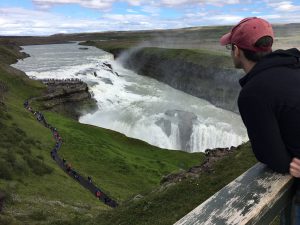 Our next stop was Geysir and the nearby Strokkur. Both geysirs are surrounded by bubbly pools, making for a fun and sulfurous experience. Geysir doesn’t erupt anymore, but Strokkur does so every ten minutes or less. Standing there waiting for it to erupt is literally watching water come to boil, but don’t look down at your phone: It’ll erupt and be over in just a moment, and you won’t want to miss it.
Our next stop was Geysir and the nearby Strokkur. Both geysirs are surrounded by bubbly pools, making for a fun and sulfurous experience. Geysir doesn’t erupt anymore, but Strokkur does so every ten minutes or less. Standing there waiting for it to erupt is literally watching water come to boil, but don’t look down at your phone: It’ll erupt and be over in just a moment, and you won’t want to miss it.
Our final site was Gullfoss, but not before I spotted a horseback riding area and pulled the car over to take a picture with some of the majestic Icelandic horses. Gullfoss was gorgeous because of its sheer size: It was wider compared to the other waterfalls we’d seen, and the spray was incredible—be prepared to get wet.
Day 5: South Coast
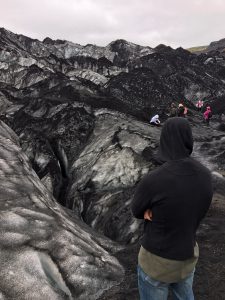 On our last day in Iceland, we took a tour of the South Coast, which may have been our favorite portion of the trip. The waterfalls Seljalandsfoss and Skogafoss offered different experiences from the others we’d seen; the former had a walkway behind the waterfall, and while it was wet, it was really cool to view it from the cave behind it. The latter had a high climb to the top, where you could see other ripples leading to the falls, and a pretty winding
On our last day in Iceland, we took a tour of the South Coast, which may have been our favorite portion of the trip. The waterfalls Seljalandsfoss and Skogafoss offered different experiences from the others we’d seen; the former had a walkway behind the waterfall, and while it was wet, it was really cool to view it from the cave behind it. The latter had a high climb to the top, where you could see other ripples leading to the falls, and a pretty winding 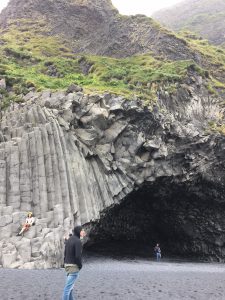 river.
river.
Our visit to Sólheimajökull* was a real hit to the gut. The massive glacier is gradually melting; and while you’ll learn that just 25 years ago it extended all the way to the parking lot, you might not believe it when you make the actual walk from the parking lot to the glacier and see how much it has melted. We were able to climb the glacier and see the black, white, and blue formation, and say a quick prayer for the earth. (Alternate activity: Vatnajokull Ice Cap at the Skaftafell National Park)
Our very last stop was Reynisjara, a black sand beach near the southern town of Vik. The first thing to note about beaches like this one is that there are sneaker waves—waves that come out of nowhere, snatch up tourists, and pull them into the ocean, never to be seen again. It was my prerogative to just stay far from the shore and admire the incredible basalt formations and caves. Of course, then we noticed puffins flying to and from the cliffside and then I flipped out and, in short, it was a struggle for my husband to make me leave. #puffinlife
Bring your students to Iceland! The country is packed with fascinating natural phenomena, including puffins. Check out our tours and contact us to get started.

